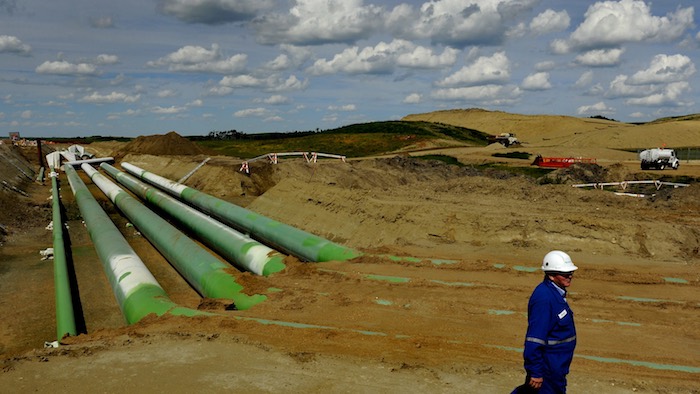Alberta
Cancelling Keystone XL cost thousands of jobs and billions in GDP: U.S. government report

Keystone facility at Hardisty, Alberta. Photo courtesy Getty Images
From the Canadian Energy Centre Ltd.
Politicians, Indigenous leaders, and labour unions criticized the cancellation for the significant consequences it could have for both Canada and the United States
There is no doubt that Keystone XL’s cancellation was a massive gut punch to Canada and its oil and gas industry. Now the analysis is out showing the impact it had on the United States.
Just a sliver over two years ago the U.S. government nixed the pipeline project which would have added an additional 830,000 barrels of oil per day into the U.S.
The pipeline, which was expected to be complete in 2023, would have provided thousands of jobs and billions in economic activity. In December, the U.S. Department of Energy released its congressionally mandated report on the matter, and it’s now known approximately how many jobs and billions of dollars were foregone due to the cancellation.
The highlighted impacts in the report show that about 20,000 potential construction jobs per year over a two-year period were lost.
The nixing of the project also had a direct impact on the U.S. GDP with a loss of $3.4 billion. Wages were also impacted, with an estimated loss of $2.05 billion in potential earnings.
While there have not been any government numbers released for Canadian job losses, TC Energy said at the time of the cancellation that 1,000 workers would be laid off due to the announcement. It was a missed opportunity to lower costs for U.S. consumers, according to the American Petroleum Institute. Indigenous groups were also impacted by the cancellation.
Dale Swampy, president of the National Coalition of Chiefs noted that “It’s quite a blow to the First Nations that are involved right now in working with TC Energy to access employment training and contracting opportunities.”
Natural Law Energy, an Indigenous-owned energy company, had signed an agreement to invest a $1 billion equity stake in the pipeline. This would have had the potential to create jobs and economic opportunity for Indigenous communities, Natural Law Energy said. More than $600 million in supply and employment agreements for Indigenous-owned companies were expected to come from the project’s construction.
While celebrated by many environmental groups, the decision to cancel Keystone XL was controversial on both sides of the border. Politicians, Indigenous leaders, and labour unions criticized the cancellation for the significant consequences it could have for both Canada and the United States.
Teamsters general president Jim Hoffa’s statement strongly encouraged the U.S. government to reconsider the decision. “This executive order doesn’t just affect U.S. Teamsters; it hurts our Canadian brothers and sisters as well who work on this project. It will reduce good-paying union jobs that allow workers to provide a middle-class standard of living to their families.”
Terry O’Sullivan, general president of the Laborers’ International Union of North America said, “By blocking this 100 percent union project, and pandering to environmental extremists, a thousand union jobs will immediately vanish, and 10,000 additional jobs will be foregone.”
The United States is the world’s largest importer of oil, and Canada is its top supplier. America will continue to rely on oil imports, according to the U.S. Energy Information Administration. Absent Keystone XL, imports will come increasingly from other countries that may not have the same environmental and human rights standards as Canada.
Alberta
CPP another example of Albertans’ outsized contribution to Canada

From the Fraser Institute
By Tegan Hill
Amid the economic uncertainty fuelled by Trump’s trade war, its perhaps more important than ever to understand Alberta’s crucial role in the federation and its outsized contribution to programs such as the Canada Pension Plan (CPP).
From 1981 to 2022, Albertan’s net contribution to the CPP—meaning the amount Albertans paid into the program over and above what retirees in Alberta received in CPP payments—was $53.6 billion. In 2022 (the latest year of available data), Albertans’ net contribution to the CPP was $3.0 billion.
During that same period (1981 to 2022), British Columbia was the only other province where residents paid more into the CPP than retirees received in benefits—and Alberta’s contribution was six times greater than B.C.’s contribution. Put differently, residents in seven out of the nine provinces that participate in the CPP (Quebec has its own plan) receive more back in benefits than they contribute to the program.
Albertans pay an outsized contribution to federal and national programs, including the CPP because of the province’s relatively high rates of employment, higher average incomes and younger population (i.e. more workers pay into the CPP and less retirees take from it).
Put simply, Albertan workers have been helping fund the retirement of Canadians from coast to coast for decades, and without Alberta, the CPP would look much different.
How different?
If Alberta withdrew from the CPP and established its own standalone provincial pension plan, Alberta workers would receive the same retirement benefits but at a lower cost (i.e. lower CPP contribution rate deducted from our paycheques) than other Canadians, while the contribution rate—essentially the CPP tax rate—to fund the program would likely need to increase for the rest of the country to maintain the same benefits.
And given current demographic projections, immigration patterns and Alberta’s long history of leading the provinces in economic growth, Albertan workers will likely continue to pay more into the CPP than Albertan retirees get back from it.
Therefore, considering Alberta’s crucial role in national programs, the next federal government—whoever that may be—should undo and prevent policies that negatively impact the province and Albertans ability to contribute to Canada. Think of Bill C-69 (which imposes complex, uncertain and onerous review requirements on major energy projects), Bill C-48 (which bans large oil tankers off B.C.’s northern coast and limits access to Asian markets), an arbitrary cap on oil and gas emissions, numerous other “net-zero” targets, and so on.
Canada faces serious economic challenges, including a trade war with the United States. In times like this, it’s important to remember Alberta’s crucial role in the federation and the outsized contributions of Alberta workers to the wellbeing of Canadians across the country.
Alberta
Made in Alberta! Province makes it easier to support local products with Buy Local program

Show your Alberta side. Buy Local. |
When the going gets tough, Albertans stick together. That’s why Alberta’s government is launching a new campaign to benefit hard-working Albertans.
Global uncertainty is threatening the livelihoods of hard-working Alberta farmers, ranchers, processors and their families. The ‘Buy Local’ campaign, recently launched by Alberta’s government, encourages consumers to eat, drink and buy local to show our unified support for the province’s agriculture and food industry.
The government’s ‘Buy Local’ campaign encourages consumers to buy products from Alberta’s hard-working farmers, ranchers and food processors that produce safe, nutritious food for Albertans, Canadians and the world.
“It’s time to let these hard-working Albertans know we have their back. Now, more than ever, we need to shop local and buy made-in-Alberta products. The next time you are grocery shopping or go out for dinner or a drink with your friends or family, support local to demonstrate your Alberta pride. We are pleased tariffs don’t impact the ag industry right now and will keep advocating for our ag industry.”
Alberta’s government supports consumer choice. We are providing tools to help folks easily identify Alberta- and Canadian-made foods and products. Choosing local products keeps Albertans’ hard-earned dollars in our province. Whether it is farm-fresh vegetables, potatoes, honey, craft beer, frozen food or our world-renowned beef, Alberta has an abundance of fresh foods produced right on our doorstep.
Quick facts
- This summer, Albertans can support local at more than 150 farmers’ markets across the province and meet the folks who make, bake and grow our food.
- In March 2023, the Alberta government launched the ‘Made in Alberta’ voluntary food and beverage labelling program to support local agriculture and food sectors.
- Through direct connections with processors, the program has created the momentum to continue expanding consumer awareness about the ‘Made in Alberta’ label to help shoppers quickly identify foods and beverages produced in our province.
- Made in Alberta product catalogue website
Related information
-

 International2 days ago
International2 days agoPope Francis has died aged 88
-

 2025 Federal Election21 hours ago
2025 Federal Election21 hours agoOttawa Confirms China interfering with 2025 federal election: Beijing Seeks to Block Joe Tay’s Election
-

 International1 day ago
International1 day agoJD Vance was one of the last people to meet Pope Francis
-

 COVID-1921 hours ago
COVID-1921 hours agoNearly Half of “COVID-19 Deaths” Were Not Due to COVID-19 – Scientific Reports Journal
-

 2025 Federal Election21 hours ago
2025 Federal Election21 hours agoHow Canada’s Mainstream Media Lost the Public Trust
-

 Business2 days ago
Business2 days agoCanada Urgently Needs A Watchdog For Government Waste
-

 International1 day ago
International1 day agoPope Francis Dies on Day after Easter
-

 2025 Federal Election21 hours ago
2025 Federal Election21 hours agoReal Homes vs. Modular Shoeboxes: The Housing Battle Between Poilievre and Carney






